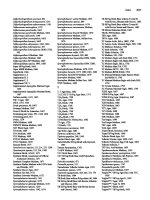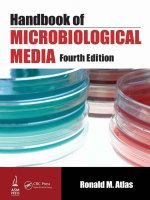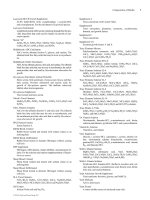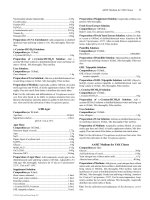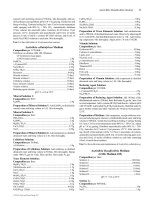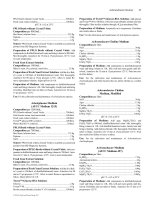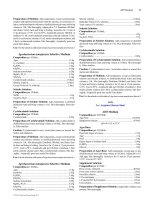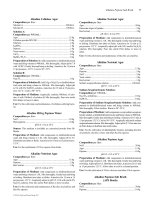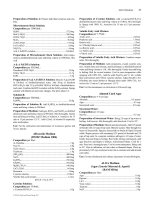Handbook of Microbiological Media, Fourth Edition part 183 pdf
Bạn đang xem bản rút gọn của tài liệu. Xem và tải ngay bản đầy đủ của tài liệu tại đây (211.6 KB, 10 trang )
Trichomonas HiVeg Agar Base with Serum and Selective Supplement 1815
Tributyrin HiVeg Agar Base with Tributyrin
Composition per liter:
Agar 15.0g
Plant peptone 5.0g
Yeast extract 3.0g
Tributyrin (glyceryl tributyrate) 10.0mL
pH 7.5 ± 0.2 at 25°C
Source: This medium, without tributyrin, is available as a premixed
powder from HiMedia.
Preparation of Medium: Add components to distilled/deionized
water and bring volume to 990.0mL. Add 10.0mL of tributyrin. Mix
thoroughly. Gently heat and bring to boiling. Distribute into tubes or
flasks. Autoclave for 15 min at 15 psi pressure–121°C. Cool to 45°–
50°C. Mix thoroughly. Pour into sterile Petri dishes or leave in tubes.
Use: For the detection of lipolytic microorganisms.
Trichlorophenol Medium
Composition per liter:
Pancreatic digest of casein 8.5g
NaCl 2.5g
Papaic digest of soybean meal 1.5g
K
2
HPO
4
1.25g
Glucose 1.25g
2,4,6-Trichlorophenol 1.25g
pH 7.3 ± 0.2 at 25°C
Preparation of Medium: Add components to distilled/deionized
water and bring volume to 1.0L. Mix thoroughly. Gently heat until dis-
solved. Distribute into tubes or flasks. Autoclave for 15 min at 15 psi
pressure–121°C.
Use: For the cultivation and maintenance of Arthrobacter species and
other microorganisms that can degrade chlorinated phenols.
Trichococcus Medium
Composition per liter:
Pancreatic digest of casein 10.0g
Na
2
SO
4
4.0g
MgCl
2
·6H
2
O 1.1g
KCl 0.7g
Glucose solution 30.0mL
pH 7.3 ± 0.2 at 25°C
Glucose Solution:
Composition
per 30.0mL:
Glucose 3.0g
Preparation of Glucose Solution: Add glucose to distilled/deion-
ized water and bring volume to 30.0mL. Mix thoroughly. Filter sterilize.
Preparation of Medium: Add components, except glucose solu-
tion, to distilled/deionized water and bring volume to 970.0mL. Mix
thoroughly. Autoclave for 15 min at 15 psi pressure–121°C. Aseptical-
ly add 30.0mL of sterile glucose solution. Mix thoroughly. Aseptically
distribute into sterile tubes or flasks.
Use: For the cultivation of Trichococcus flocculiformis.
Trichomonas HiVeg Agar Base with Serum
Composition per liter:
Plant extract No. 2 25.0g
NaCl 6.5g
Glucose 5.0g
Agar 1.0g
Horse serum 80.0mL
pH 6.4 ± 0.2 at 25°C
Source: This medium, without horse serum, is available as a pre-
mixed powder from HiMedia.
Horse Serum:
Composition
per 80.0mL:
Horse serum 80.0mL
Preparation of Horse Serum: Gently heat sterile horse serum to
56°C for 30 min. Aseptically adjust pH to 6.0 with 0.1N HCl. Use
immediately.
Preparation of Medium: Add components, except horse serum, to
distilled/deionized water and bring volume to 920.0mL. Mix thorough-
ly. Gently heat and bring to boiling. Autoclave for 15 min at 15 psi
pressure–121°C. Cool to 45°–50°C. Aseptically add 80.0mL of freshly
prepared sterile horse serum. Mix thoroughly. Aseptically distribute
into sterile tubes or flasks.
Use: For the cultivation of Trichomonas vaginalis.
Trichomonas HiVeg Agar Base
with Serum and Selective Supplement
Composition per liter:
Plant extract No. 2 25.0g
NaCl 6.5g
Glucose 5.0g
Agar 1.0g
Horse serum 80.0mL
Selective supplement 10.0mL
pH 6.4 ± 0.2 at 25°C
Source: This medium, without horse serum or selective supplement,
is available as a premixed powder from HiMedia.
Horse Serum:
Composition
per 80.0mL:
Horse serum 80.0mL
Preparation of Horse Serum: Gently heat sterile horse serum to
56°C for 30 min. Aseptically adjust pH to 6.0 with 0.1N HCl. Use
immediately.
Selective Supplement:
Composition
per 10.0mL:
Streptomycin 0.5g
Penicllin 1,000,000U
Preparation of Selective Supplement: Add components to dis-
tilled/deionized water and bring volume to 10.0mL. Mix thoroughly.
Filter sterilize.
Preparation of Medium: Add components, except horse serum
and selective supplement, to distilled/deionized water and bring vol-
ume to 910.0mL. Mix thoroughly. Gently heat and bring to boiling.
Autoclave for 15 min at 15 psi pressure–121°C. Cool to 45°–50°C.
Aseptically add 80.0mL of freshly prepared sterile horse serum and
10.0mL sterile selective supplement. Mix thoroughly. Aseptically dis-
tribute into sterile tubes or flasks.
Use: For the cultivation of Trichomonas vaginalis.
© 2010 by Taylor and Francis Group, LLC
1816 Trichomonas Medium
Trichomonas Medium
Composition per liter:
Liver digest 25.0g
NaCl 6.5g
Glucose 5.0g
Agar 1.0g
Horse serum 80.0mL
pH 6.4 ± 0.2 at 25°C
Source: This medium is available as a premixed powder from Oxoid
Unipath.
Horse Serum:
Composition
per 80.0mL:
Horse serum 80.0mL
Preparation of Horse Serum: Gently heat sterile horse serum to
56°C for 30 min. Aseptically adjust pH to 6.0 with 0.1N HCl. Use im-
mediately.
Preparation of Medium: Add components, except horse serum, to
distilled/deionized water and bring volume to 920.0mL. Mix thorough-
ly. Gently heat and bring to boiling. Autoclave for 15 min at 15 psi
pressure–121°C. Cool to 45°–50°C. Aseptically add 80.0mL of freshly
prepared sterile horse serum. Mix thoroughly. Aseptically distribute
into sterile tubes or flasks.
Use: For the cultivation of Trichomonas vaginalis.
Trichomonas Medium No. 2
Composition per liter:
Glucose 22.5g
Liver digest 18.0g
Pancreatic digest of casein 17.0g
NaCl 5.0g
Pancreatic digest of soybean meal 3.0g
K
2
HPO
4
2.5g
Chloramphenicol 0.125g
Horse serum 250.0mL
Calcium pantothenate (0.5% solution) 1.0mL
pH 6.2 ± 0.2 at 25°C
Source: This medium is available as a prepared medium from Oxoid Un-
ipath.
Preparation of Medium: Add components, except horse serum, to
distilled/deionized water and bring volume to 750.0mL. Mix thorough-
ly. Autoclave for 15 min at 5 psi pressure–108°C. Cool to 45°–50°C.
Aseptically add 250.0mL of sterile horse serum. Mix thoroughly.
Aseptically distribute into sterile tubes or flasks.
Use: For the isolation of Trichomonas vaginalis.
Trichomonas Selective Medium
Composition per liter:
Liver digest 25.0g
NaCl 6.5g
Glucose 5.0g
Agar 1.0g
Horse serum 80.0mL
Antibiotic inhibitor 10.0mL
pH 6.4 ± 0.2 at 25°C
Source: This medium is available as a premixed powder from Oxoid
Unipath.
Horse Serum:
Composition
per 80.0mL:
Horse serum 80.0mL
Preparation of Horse Serum: Gently heat sterile horse serum to
56°C for 30 min. Aseptically adjust pH to 6.0 with 0.1N HCl. Use im-
mediately.
Antibiotic Inhibitor:
Composition
per 10.0mL:
Streptomycin 500.0mg
Penicillin G 1,000,000U
Preparation of Antibiotic Inhibitor: Add components to dis-
tilled/deionized water and bring volume to 10.0mL. Mix thoroughly.
Filter sterilize.
Preparation of Medium: Add components, except horse serum
and antibiotic inhibitor, to distilled/deionized water and bring volume
to 910.0mL. Mix thoroughly. Gently heat and bring to boiling. Auto-
clave for 15 min at 15 psi pressure–121°C. Cool to 45°–50°C. Asepti-
cally add 80.0mL of freshly prepared sterile horse serum and 10.0mL
of sterile antibiotic inhibitor. Mix thoroughly. Aseptically distribute
into sterile tubes or flasks.
Use: For the cultivation of Trichomonas vaginalis from specimens
with a mixed bacterial flora.
Trichomonas Selective Medium
Composition per liter:
Liver digest 25.0g
NaCl 6.5g
Glucose 5.0g
Agar 1.0g
Horse serum 80.0mL
Antibiotic inhibitor 10.0mL
pH 6.4 ± 0.2 at 25°C
Horse Serum:
Composition
per 80.0mL:
Horse serum 80.0mL
Preparation of Horse Serum: Gently heat sterile horse serum to
56°C for 30 min. Aseptically adjust pH to 6.0 with 0.1N HCl. Use im-
mediately.
Antibiotic Inhibitor:
Composition
per 10.0mL:
Chloramphenicol 100.0mg
Preparation of Antibiotic Inhibitor: Add chloramphenicol to dis-
tilled/deionized water and bring volume to 10.0mL. Mix thoroughly. Filter
sterilize.
Preparation of Medium: Add components, except horse serum and
antibiotic inhibitor, to distilled/deionized water and bring volume to
910.0mL. Mix thoroughly. Gently heat and bring to boiling. Autoclave
for 15 min at 15 psi pressure–121°C. Cool to 45°–50°C. Aseptically add
80.0mL of freshly prepared sterile horse serum and 10.0mL of sterile an-
tibiotic inhibitor. Mix thoroughly. Aseptically distribute into sterile tubes
or flasks.
Use: For the cultivation of Trichomonas vaginalis from specimens
with a mixed bacterial flora.
Trichophyton Agar 1
Composition per liter:
Glucose 40.0g
Agar 15.0g
© 2010 by Taylor and Francis Group, LLC
Trichophyton Agar 7 1817
Vitamin assay casamino acids 2.5g
KH
2
PO
4
1.8g
MgSO
4
·7H
2
O 0.1g
pH 6.8 ± 0.2 at 25°C
Source: This medium is available as a premixed powder from BD Di-
agnostic Systems.
Preparation of Medium: Add components to distilled/deionized
water and bring volume to 1.0L. Mix thoroughly. Gently heat and bring
to boiling. Distribute into tubes. Autoclave for 15 min at 15 psi pres-
sure–121°C. Allow tubes to cool in a slanted position.
Use: For the differentiation of the Trichophyton species.
Trichophyton Agar 2
Composition per liter:
Glucose 40.0g
Agar 15.0g
Vitamin assay casamino acids 2.5g
KH
2
PO
4
1.8g
MgSO
4
·7H
2
O 0.1g
Inositol 50.0mg
pH 6.8 ± 0.2 at 25°C
Source: This medium is available as a premixed powder from BD Di-
agnostic Systems.
Preparation of Medium: Add components to distilled/deionized
water and bring volume to 1.0L. Mix thoroughly. Gently heat and bring
to boiling. Distribute into tubes. Autoclave for 15 min at 15 psi pres-
sure–121°C. Allow tubes to cool in a slanted position.
Use: For the differentiation of the Trichophyton species.
Trichophyton Agar 3
Composition per liter:
Glucose 40.0g
Agar 15.0g
Vitamin assay casamino acids 2.5g
KH
2
PO
4
1.8g
MgSO
4
·7H
2
O 0.1g
Inositol 0.05g
Thiamine·HCl 0.2mg
pH 6.8 ± 0.2 at 25°C
Source: This medium is available as a premixed powder from BD Di-
agnostic Systems.
Preparation of Medium: Add components to distilled/deionized
water and bring volume to 1.0L. Mix thoroughly. Gently heat and bring
to boiling. Distribute into tubes. Autoclave for 15 min at 15 psi pres-
sure–121°C. Allow tubes to cool in a slanted position.
Use: For the differentiation of the Trichophyton species.
Trichophyton Agar 4
Composition per liter:
Glucose 40.0g
Agar 15.0g
Vitamin assay casamino acids 2.5g
KH
2
PO
4
1.8g
MgSO
4
·7H
2
O 0.1g
Thiamine·HCl USP 200.0μg
pH 6.8 ± 0.2 at 25°C
Source: This medium is available as a premixed powder from BD Di-
agnostic Systems.
Preparation of Medium: Add components to distilled/deionized
water and bring volume to 1.0L. Mix thoroughly. Gently heat and bring
to boiling. Distribute into tubes. Autoclave for 15 min at 15 psi pres-
sure–121°C. Allow tubes to cool in a slanted position.
Use: For the differentiation of the Trichophyton species.
Trichophyton Agar 5
Composition per liter:
Glucose 40.0g
Agar 15.0g
Vitamin assay casamino acids 2.5g
KH
2
PO
4
1.8g
MgSO
4
·7H
2
O 0.1g
Nicotinic acid 2.0mg
pH 6.8 ± 0.2 at 25°C
Source: This medium is available as a premixed powder from BD Di-
agnostic Systems.
Preparation of Medium: Add components to distilled/deionized
water and bring volume to 1.0L. Mix thoroughly. Gently heat and bring
to boiling. Distribute into tubes. Autoclave for 15 min at 15 psi pres-
sure–121°C. Allow tubes to cool in a slanted position.
Use: For the differentiation of the Trichophyton species.
Trichophyton Agar 6
Composition per liter:
Glucose 40.0g
Agar 15.0g
KH
2
PO
4
1.8g
Ammonium nitrate 1.5g
MgSO
4
·7H
2
O 0.1g
pH 6.8 ± 0.2 at 25°C
Source: This medium is available as a premixed powder from BD Di-
agnostic Systems.
Preparation of Medium: Add components to distilled/deionized wa-
ter and bring volume to 1.0L. Mix thoroughly. Gently heat and bring to
boiling. Distribute into tubes. Autoclave for 15 min at 15 psi pressure–
121°C. Allow tubes to cool in a slanted position.
Use: For the differentiation of the Trichophyton species.
Trichophyton Agar 7
Composition per liter:
Glucose 40.0g
Agar 15.0g
KH
2
PO
4
1.8g
Ammonium nitrate 1.5g
MgSO
4
·7H
2
O 0.1g
Histidine·HCl 0.03g
pH 6.8 ± 0.2 at 25°C
Source: This medium is available as a premixed powder from BD Di-
agnostic Systems.
Preparation of Medium: Add components to distilled/deionized
water and bring volume to 1.0L. Mix thoroughly. Gently heat and bring
to boiling. Distribute into tubes. Autoclave for 15 min at 15 psi pres-
sure–121°C. Allow tubes to cool in a slanted position.
© 2010 by Taylor and Francis Group, LLC
1818 Trichophyton HiVeg Agar 1
Use: For the differentiation of the Trichophyton species.
Trichophyton HiVeg Agar 1
Composition per liter:
Glucose 40.0g
Agar 15.0g
Vitamin-free casein enzymic hydrolysate 2.5g
KH
2
PO
4
1.8g
MgSO
4
0.1g
pH 6.8 ± 0.2 at 25°C
Source: This medium is available as a premixed powder from Hi-
Media.
Preparation of Medium: Add components to distilled/deionized
water and bring volume to 1.0L. Mix thoroughly. Gently heat and bring
to boiling. Distribute into tubes. Autoclave for 15 min at 15 psi pres-
sure–121°C. Allow tubes to cool in a slanted position.
Use: For the differentiation of the Trichophyton species.
Trichophyton HiVeg Agar 2
Composition per liter:
Glucose 40.0g
Agar 15.0g
Vitamin-free plant hydrolysate 2.5g
KH
2
PO
4
1.8g
MgSO
4
0.1g
Inositol 5.0mg
pH 6.8 ± 0.2 at 25°C
Source: This medium is available as a premixed powder from Hi-
Media.
Preparation of Medium: Add components to distilled/deionized
water and bring volume to 1.0L. Mix thoroughly. Gently heat and bring
to boiling. Distribute into tubes. Autoclave for 15 min at 15 psi pres-
sure–121°C. Allow tubes to cool in a slanted position.
Use: For the differentiation of the Trichophyton species.
Trichophyton HiVeg Agar 3
Composition per liter:
Glucose 40.0g
Agar 15.0g
Vitamin-free plant hydrolysate 2.5g
KH
2
PO
4
1.8g
MgSO
4
0.1g
Inositol 5.0mg
Thiamine 5.0mg
pH 6.8 ± 0.2 at 25°C
Source: This medium is available as a premixed powder from Hi-
Media.
Preparation of Medium: Add components to distilled/deionized
water and bring volume to 1.0L. Mix thoroughly. Gently heat and bring
to boiling. Distribute into tubes. Autoclave for 15 min at 15 psi pres-
sure–121°C. Allow tubes to cool in a slanted position.
Use: For the differentiation of the Trichophyton species.
Trichophyton HiVeg Agar 4
Composition per liter:
Glucose 40.0g
Agar 15.0g
KH
2
PO
4
1.8g
MgSO
4
0.1g
Vitamin-free plant hydrolysate 2.5g
Thiamine hydrochloride 0.2mg
pH 6.8 ± 0.2 at 25°C
Source: This medium is available as a premixed powder from Hi-
Media.
Preparation of Medium: Add components to distilled/deionized
water and bring volume to 1.0L. Mix thoroughly. Gently heat and bring
to boiling. Distribute into tubes. Autoclave for 15 min at 15 psi pres-
sure–121°C. Allow tubes to cool in a slanted position.
Use: For the differentiation of the Trichophyton species.
Trichophyton HiVeg Agar 5
Composition per liter:
Glucose 40.0g
Agar 15.0g
Vitamin-free plant hydrolysate 2.5g
KH
2
PO
4
1.8g
MgSO
4
0.1g
Nicotinic acid 0.02g
pH 6.8 ± 0.2 at 25°C
Source: This medium is available as a premixed powder from BD Di-
agnostic Systems.
Preparation of Medium: Add components to distilled/deionized
water and bring volume to 1.0L. Mix thoroughly. Gently heat and bring
to boiling. Distribute into tubes. Autoclave for 15 min at 15 psi pres-
sure–121°C. Allow tubes to cool in a slanted position.
Use: For the differentiation of the Trichophyton species.
Trichosel™ Broth, Modified
Composition per liter:
Pancreatic digest of casein 12.0g
Yeast extract 5.0g
Liver extract 2.0g
Maltose 2.0g
L-Cysteine·HCl 1.0g
Agar 1.0g
Chloramphenicol 0.1g
Methylene Blue 3.0mg
Horse serum 50.0mL
pH 6.0 ± 0.2 at 25°C
Source: This medium is available as a premixed powder from BD Di-
agnostic Systems.
Preparation of Medium:
Add components, except horse serum, to
distilled/deionized water and bring volume to 950.0mL. Mix thorough-
ly. Gently heat while stirring and bring to boiling. Autoclave for 15 min
at 13 psi pressure–118°C. Cool to 45°–50°C. Aseptically add 50.0mL
of sterile horse serum. Mix thoroughly. Aseptically distribute into ster-
ile tubes or flasks.
Use: For the isolation and cultivation of Trichomonas species.
Trimethylamine N-Oxide Medium
(TMAO Medium)
Composition per liter:
Beef extract 10.0g
Peptone 10.0g
NaCl 5.0g
© 2010 by Taylor and Francis Group, LLC
Triple Sugar Iron Agar, HiVeg 1819
Agar 2.0g
Trimethylamine N-oxide 1.0g
Yeast extract 1.0g
pH 7.5 ± 0.2 at 25°C
Source: This medium is available as a premixed powder from Oxoid
Unipath.
Preparation of Medium: Add components to distilled/deionized
water and bring volume to 1.0L. Mix thoroughly. Gently heat and
bring to boiling. Distribute into screw-capped tubes in 4.0mL vol-
umes. Autoclave for 15 min at 15 psi pressure–121°C. Allow tubes
to cool in an upright position.
Use: For the cultivation and differentiation of Campylobacter species
from foods. Campylobacter jejuni and Campylobacter coli will not
grow.
Triple Sugar Iron Agar
(TSI Agar)
Composition per liter:
Peptone 20.0g
Agar 12.0g
Lactose 10.0g
Sucrose 10.0g
NaCl 5.0g
Beef extract 3.0g
Yeast extract 3.0g
Glucose 1.0g
Ferric citrate 0.3g
Na
2
S
2
O
3
0.3g
Phenol Red 0.025g
pH 7.4 ± 0.2 at 25°C
Source: This medium is available as a premixed powder from BD Di-
agnostic Systems and Oxoid Unipath.
Preparation of Medium: Add components to distilled/deionized
water and bring volume to 1.0L. Mix thoroughly. Gently heat and bring
to boiling. Distribute into tubes or flasks. Autoclave for 15 min at 15
psi pressure–121°C. Allow tubes to cool in a slanted position to form a
1.0-inch butt.
Use: For the differentiation of members of the Enterobacteriaceae
based on their fermentation of lactose, sucrose, and glucose and the
production of H
2
S.
Triple Sugar Iron Agar
(TSI Agar)
Composition per liter:
Agar 13.0g
Pancreatic digest of casein 10.0g
Peptic digest of animal tissue 10.0g
Lactose 10.0g
Sucrose 10.0g
NaCl 5.0g
Glucose 1.0g
Fe(NH
4
)
2
(SO
4
)
2
·6H
2
O 0.2g
Na
2
S
2
O
3
0.2g
Phenol Red 0.025g
pH 7.3 ± 0.2 at 25°C
Source: This medium is available as a premixed powder from BD Di-
agnostic Systems.
Preparation of Medium:
Add components to distilled/deionized
water and bring volume to 1.0L. Mix thoroughly. Gently heat and bring
to boiling. Distribute into tubes or flasks. Autoclave for 15 min at 15
psi pressure–121°C. Allow tubes to cool in a slanted position to form a
1.0-inch butt.
Use: For the differentiation of members of the Enterobacteriaceae
based on their fermentation of lactose, sucrose, and glucose and the
production of H
2
S.
Triple Sugar Iron Agar
(TSI Agar)
(BAM M149 Medium 2)
Composition per liter:
Peptone 15.0g
Agar 12.0g
Lactose 10.0g
Sucrose 10.0g
Proteose peptone 5.0g
NaCl 5.0g
Beef extract 3.0g
Yeast extract 3.0g
Glucose 1.0g
Na
2
S
2
O
3
0.3g
FeSO
4
0.2g
Phenol Red 0.024g
pH 7.4 ± 0.2 at 25°C
Preparation of Medium: Add components to distilled/deionized
water and bring volume to 1.0L. Mix thoroughly. Gently heat and bring
to boiling. Distribute into tubes or flasks. Autoclave for 15 min at 15
psi pressure–121°C. Allow tubes to cool in a slanted position to form
a 1.0-inch butt.
Use: For the differentiation of members of the Enterobacteriaceae
based on their fermentation of lactose, sucrose, and glucose and the
production of H
2
S.
Triple Sugar Iron Agar, HiVeg
Composition per liter:
Agar 12.0g
Plant hydrolysate 10.0g
Plant peptone 10.0g
Lactose 10.0g
Sucrose 10.0g
NaCl 5.0g
Plant extract 3.0g
Yeast extract 3.0g
Glucose 1.0g
Na
2
S
2
O
3
0.3g
FeSO
4
0.2g
Phenol Red 0.024g
pH 7.4 ± 0.2 at 25°C
Source: This medium is available as a premixed powder from Hi-
Media.
Preparation of Medium: Add components to distilled/deionized
water and bring volume to 1.0L. Mix thoroughly. Gently heat and bring
to boiling. Distribute into tubes or flasks. Autoclave for 15 min at 15
psi pressure–121°C. Allow tubes to cool in a slanted position to form a
1.0-inch butt.
© 2010 by Taylor and Francis Group, LLC
1820 Tris YP Agar
Use: For the differentiation of members of the Enterobacteriaceae
based on their fermentation of lactose, sucrose, and glucose and the
production of H
2
S.
Tris YP Agar
(Tris Yeast Extract Peptone Agar)
Composition per liter:
Agar 19.0g
Yeast extract 3.0g
Glucose 1.0g
Peptone 0.6g
Tris buffer (0.05M, pH 7.5) 1.0L
pH 7.5 ± 0.2 at 25°C
Preparation of Medium: Add components to distilled/deionized
water and bring volume to 1.0L. For top layer agar, add 6.0g of agar
instead of 19.0g. Mix thoroughly. Gently heat and bring to boiling. Dis-
tribute into tubes or flasks. Autoclave for 15 min at 15 psi pressure–
121°C. Pour into sterile Petri dishes.
Use: For the cultivation and maintenance of Bdellovibrio species.
Tris YP Broth
(Tris Yeast Extract Peptone Broth)
Composition per liter:
Yeast extract 3.0g
Glucose 1.0g
Peptone 0.6g
Tris buffer (0.05M, pH 7.5) 1.0L
pH 7.5 ± 0.2 at 25°C
Preparation of Medium: Add components to distilled/deionized
water and bring volume to 1.0L. Mix thoroughly. Distribute into tubes
or flasks. Autoclave for 15 min at 15 psi pressure–121°C.
Use: For the cultivation and maintenance of Bdellovibrio species.
Trypaflavin Nalidixic Acid Serum Agar
(TNSA Agar)
Composition per liter:
Ionagar No. 2 12.0g
Peptone 10.0g
Beef extract 3.0g
H
2
O 926.5mL
Bovine serum, heat inactivated 50.0mL
Nalidixic acid solution 20.0mL
Trypaflavin solution 3.5mL
pH 7.2–7.4 at 25°C
Nalidixic Acid Solution:
Composition
per 10.0mL:
Nalidixic acid 0.02g
Preparation of Nalidixic Acid Solution: Add nalidixic acid to
distilled/deionized water and bring volume to 10.0mL. Mix thorough-
ly. Filter sterilize.
Trypaflavin Solution:
Composition
per 10.0mL:
Trypaflavin 0.1g
Preparation of Trypaflavin Solution: Add trypaflavin to dis-
tilled/deionized water and bring volume to 10.0mL. Mix thoroughly.
Filter sterilize.
Preparation of Medium: Add components—except bovine serum,
nalidixic acid solution, and trypaflavin solution—to distilled/deionized
water and bring volume to 926.5mL. Mix thoroughly. Gently heat and
bring to boiling. Autoclave for 15 min at 15 psi pressure–121°C. Cool
to 45°–50°C. Aseptically add 50.0mL of sterile bovine serum, 20.0mL
of sterile nalidixic acid solution, and 3.5mL of trypaflavin solution.
Mix thoroughly. Pour into sterile Petri dishes or distribute into sterile
tubes.
Use: For the isolation and cultivation of Listeria species from preen-
riched specimens.
Trypanosome Medium
Composition per 1300.0mL:
Solid phase 1.0L
Liquid phase (Locke’s solution) 300.0mL
pH 7.2–7.4 at 25°C
Solid Phase:
Composition
per liter:
Agar 15.0g
NaCl 8.0g
Peptone 5.0g
Beef extract 3.0g
Rabbit blood, defibrinated 300.0mL
Preparation of Solid Phase: Add components, except rabbit
blood, to distilled/deionized water and bring volume to 700.0mL. Mix
thoroughly. Adjust pH to 7.2–7.4. Gently heat and bring to boiling. Au-
toclave for 15 min at 15 psi pressure–121°C. Cool to 50°–55°C. Asep-
tically add 300.0mL of sterile defibrinated rabbit blood. Mix
thoroughly. Distribute 10.0mL aliquots into sterile screw-capped
tubes. Allow to solidify in a slanted position.
Liquid Phase (Locke’s Solution):
Composition
per liter:
NaCl 8.0g
Glucose 2.5g
KH
2
PO
4
0.3g
CaCl
2
0.2g
KCl 0.2g
Preparation of Liquid Phase (Locke’s Solution): Add compo-
nents to distilled/deionized water and bring volume to 1.0L. Mix thor-
oughly. Autoclave for 15 min at 15 psi pressure–121°C.
Preparation of Medium: Aseptically overlay agar slants (solid
phase) with 3.0mL per tube of sterile liquid phase (Locke’s solution).
Use: For the cultivation of Leishmania donovani, Leishmania brazil-
iensis, Trypanosoma gambiense, and Trypanosoma rhodesiense.
Tryptic Digest Broth
Composition per liter:
Tryptic digest of beef heart 10.0g
NaCl 5.0g
Glucose 1.0g
pH 7.6 ± 0.2 at 25°C
Source: This medium is available as a premixed powder from BD Di-
agnostic Systems.
Preparation of Medium: Add components to distilled/deionized
water and bring volume to 1.0L. Mix thoroughly. Distribute into tubes
or flasks. Autoclave for 15 min at 15 psi pressure–121°C.
© 2010 by Taylor and Francis Group, LLC
Tryptic Soy Agar with 0.6% Yeast Extract 1821
Use: For use as a base medium to which enrichments are added. For
the cultivation of fastidious microorganisms.
Tryptic Nitrate Medium
Composition per liter:
Tryptose 20.0g
Na
2
HPO
4
2.0g
Agar 1.0g
Glucose 1.0g
KNO
3
1.0g
pH 7.6 ± 0.2 at 25°C
Source: This medium is available as a premixed powder from BD Di-
agnostic Systems.
Preparation of Medium: Add components to distilled/deionized
water and bring volume to 1.0L. Mix thoroughly. Gently heat and bring
to boiling. Distribute into tubes in 10.0mL volumes. Autoclave for 15
min at 15 psi pressure–121°C.
Use: For the cultivation and differentiation of Pseudomonas and
related genera. For the differentiation of bacteria based on their reduc-
tion of nitrate to nitrite. After incubation of the bacterium in tryptic
nitrate medium for 18–24 hr, sulfanillic acid and α-naphthol reagents
are added. Nitrate reduction is indicated by the development of a red to
violet color.
Tryptic Soy Agar
See: Trypticase™ Soy Agar
Tryptic Soy Agar Blood Agar Base
See: Trypticase™ Soy Agar with Sheep Blood
Tryptic Soy Agar with Magnesium Ions
Composition per liter:
Pancreatic digest of casein 17.0g
Agar 15.0g
NaCl 5.0g
Pancreatic digest of soybean meal 3.0g
Glucose 2.5g
K
2
HPO
4
2.5g
MgCl
2
0.95g
pH 7.3 ± 0.2 at 25°C
Preparation of Medium: Add components to tap water and bring
volume to 1.0L. Mix thoroughly. Gently heat and bring to boiling. Dis-
tribute into tubes or flasks. Autoclave for 15 min at 15 psi pressure–
121°C. Pour into sterile Petri dishes or leave in tubes.
Use: For the cultivation of Escherichia coli for bacteriophage produc-
tion.
Tryptic Soy Agar with Magnesium Sulfate
Composition per liter:
Agar 15.0g
Pancreatic digest of casein 15.0g
NaCl 5.0g
Pancreatic digest of soybean meal 5.0g
MgSO
4
·7H
2
O 1.5g
pH 7.3 ± 0.2 at 25°C
Preparation of Medium: Add components to distilled/deionized
water and bring volume to 1.0L. Mix thoroughly. Gently heat and bring
to boiling. Autoclave for 15 min at 15 psi pressure–121°C. Pour into
sterile Petri dishes in 20.0mL volumes.
Use: For the cultivation of Escherichia coli from foods.
Tryptic Soy Agar with Magnesium
Sulfate and Sodium Chloride
Composition per liter:
Pancreatic digest of casein 50.0g
NaCl 30.0g
Agar 15.0g
Pancreatic digest of soybean meal 5.0g
MgSO
4
·7H
2
O 1.5g
pH 7.3 ± 0.2 at 25°C
Preparation of Medium: Add components to distilled/deionized
water and bring volume to 1.0L. Mix thoroughly. Gently heat and bring
to boiling. Autoclave for 15 min at 15 psi pressure–121°C. Pour into
sterile Petri dishes in 20.0mL volumes.
Use: For the cultivation of Vibrio species from foods.
Tryptic Soy Agar with Sodium Chloride
(ATCC Medium 2276)
Composition per liter:
Pancreatic digest of casein 50.0g
NaCl 20.0g
Agar 15.0g
Pancreatic digest of soybean meal 5.0g
MgSO
4
·7H
2
O 1.5g
pH 7.3 ± 0.2 at 25°C
Preparation of Medium: Add components to distilled/deionized
water and bring volume to 1.0L. Mix thoroughly. Gently heat and bring
to boiling. Autoclave for 15 min at 15 psi pressure–121°C. Pour into
sterile Petri dishes or leave in tubes.
Use: For the cultivation of Vibrio species.
Tryptic Soy Agar with 0.6% Yeast Extract
Composition per liter:
Agar 15.0g
Pancreatic digest of casein 15.0g
Yeast extract 6.0g
Pancreatic digest of soybean meal 5.0g
NaCl 5.0g
pH 7.0–7.5 at 25°C
Source: This medium is available as a premixed powder from BD Di-
agnostic Systems.
Preparation of Medium: Add components to distilled/deionized
water and bring volume to 1.0L. Mix thoroughly. Gently heat and bring
to boiling. Distribute into tubes or flasks. Autoclave for 15 min at 15
psi pressure–121°C. Pour into sterile Petri dishes or leave in tubes.
Use: For the isolation and cultivation of Listeria monocytogenes from
foods.
Tryptic Soy Blood Agar
See: Trypticase™ Soy Agar
with Sheep Blood
Tryptic Soy Blood Agar with VAN 4
See: Trypticase™ Soy Agar
with Sheep Blood and Vancomycin
© 2010 by Taylor and Francis Group, LLC
1822 Tryptic Soy Broth
Tryptic Soy Broth
Composition per liter:
Pancreatic digest of casein 18.0g
Papaic digest of soybean meal 6.0g
NaCl 6.0g
pH 7.3 ± 0.2 at 25°C
Source: This medium is available as a premixed powder from BD Di-
agnostic Systems.
Preparation of Medium: Add components to distilled/deionized
water and bring volume to 1.0L. Mix thoroughly. Gently heat and bring
to boiling. Distribute into tubes or flasks. Autoclave for 15 min at 15
psi pressure–121°C. Mix thoroughly.
Use: For the isolation and cultivation of a wide variety of microorgan-
isms.
Tryptic Soy Broth with 0.001M Calcium Chloride
(ATCC Medium 1380)
Composition
per liter:
Pancreatic digest of casein 18.0g
Papaic digest of soybean meal 6.0g
NaCl 6.0g
CaCl
2
solution 10.0mL
pH 7.3 ± 0.2 at 25°C
Source: This medium, without CaCl
2
, is available as a premixed pow-
der from BD Diagnostic Systems.
Calcium Chloride Solution:
Composition
per 10.0mL:
CaCl
2
0.111g
Preparation of Calcium Chloride Solution: Add CaCl
2
to dis-
tilled/deionized water and bring volume to 10.0mL. Mix thoroughly.
Filter sterilize.
Preparation of Medium: Add components, except CaCl
2
solution,
to distilled/deionized water and bring volume to 990mL. Mix thor-
oughly. Gently heat and bring to boiling. Autoclave for 15 min at 15 psi
pressure–121°C. Aseptically add 10.0mL CaCl
2
solution. Mix thor-
oughly. Distribute into tubes or flasks.
Use: For the isolation and cultivation of Bronchothrix thermospacta.
Tryptic Soy Broth with 0.1% Potassium Nitrate
(ATCC Medium 1183)
Composition
per liter:
Pancreatic digest of casein 15.0g
Agar 15.0g
Papaic digest of soybean meal 5.0g
NaCl 5.0g
KNO
3
1.0g
pH 7.3 ± 0.2 at 25°C
Source: This medium, without nitrate, is available as a premixed pow-
der from BD Diagnostic Systems.
Preparation of Medium: Add components to distilled/deionized
water and bring volume to 1.0L. Mix thoroughly. Gently heat and bring
to boiling. Distribute into tubes or flasks. Autoclave for 15 min at 15
psi pressure–121°C. Do not overheat. Pour into sterile Petri dishes or
leave in tubes.
Use: For the isolation and cultivation of Flavobacterium sp.
Tryptic Soy Broth with Magnesium Ions
(ATCC Medium 1588)
Composition per liter:
Pancreatic digest of casein 17.0g
NaCl 5.0g
Pancreatic digest of soybean meal 3.0g
Glucose 2.5g
K
2
HPO
4
2.5g
MgCl
2
0.95g
pH 7.3 ± 0.2 at 25°C
Preparation of Medium: Add components to distilled/deionized
water and bring volume to 1.0L. Mix thoroughly. Distribute into flasks
or tubes. Autoclave for 15 min at 15 psi pressure–121°C.
Use: For the cultivation of Escherichia coli for bacteriophage produc-
tion.
Tryptic Soy Broth with 1M Potassium Chloride
(ATCC Medium 2074)
Composition
per liter:
KCl 74.5g
Pancreatic digest of casein 17.0g
NaCl 5.0g
Papaic digest of soybean meal 3.0g
K
2
HPO
4
2.5g
Glucose 2.5g
pH 7.3 ± 0.2 at 25°C
Preparation of Medium: Add components to distilled/deionized
water and bring volume to 1.0L. Mix thoroughly. Distribute into tubes
or flasks. Autoclave for 15 min at 15 psi pressure–121°C.
Use: For the cultivation and maintenance of Gracilibacillus dipso-
sauri.
Tryptic Soy Fast Green Agar
(TSFA)
Composition per liter:
Pancreatic digest of casein 17.0g
Agar 15.0g
NaCl 5.0g
Papaic digest of soybean meal 3.0g
K
2
HPO
4
2.5g
Glucose 2.5g
Fast Green FCF 0.25g
pH 7.3 ± 0.2 at 25°C
Preparation of Medium: Add components to distilled/deionized
water and bring volume to 1.0L. Mix thoroughly. Gently heat and bring
to boiling. Distribute into tubes or flasks. Autoclave for 15 min at 15
psi pressure–121°C. Cool to 45°–50°C. Aseptically adjust pH to 7.3.
Pour into sterile Petri dishes.
Use: For the isolation and cultivation of Salmonella species from
foods.
Trypticase™ Agar Base
Composition per liter:
Pancreatic digest of casein 20.0g
Agar 3.5g
Phenol Red 0.02g
pH 7.4 ± 0.2 at 25°C
Source: This medium is available as a premixed powder from BD Di-
agnostic Systems and Oxoid Unipath.
© 2010 by Taylor and Francis Group, LLC
Trypticase™ Peptone Glucose Yeast Extract Broth, Buffered 1823
Preparation of Medium: Add components to distilled/deionized
water and bring volume to 1.0L. Mix thoroughly. Gently heat and bring
to boiling. Distribute into tubes or flasks. Autoclave for 15 min at 15
psi pressure–121°C. Pour into sterile Petri dishes or leave in tubes.
Use: For the differentiation of microorganisms based on their motility.
Trypticase™ Agar Base with Carbohydrate
Composition per liter:
Pancreatic digest of casein 20.0g
Carbohydrate 5.0g
Agar 3.5g
Phenol Red 0.02g
pH 7.4 ± 0.2 at 25°C
Preparation of Medium: Add components to distilled/deionized
water and bring volume to 1.0L. Mix thoroughly. Gently heat and bring
to boiling. Distribute into tubes. Autoclave for 15 min at 13 psi pres-
sure–118°C. Do not overheat. Pour into sterile Petri dishes or leave in
tubes.
Use: For differentiation of microorganisms based on their motility and
fermentation reactions. Fermentation of carbohydrate turns the medium
yellow.
Trypticase™ Azolectin Tween™ Broth Base
See: TAT Broth Base
Trypticase™ Broth, Supplemented
Composition per liter:
Pancreatic digest of casein 20.0g
MgSO
4
·7H
2
O 0.015g
FeCl
3
7.0mg
pH 7.2 ± 0.2 at 25°C
Preparation of Medium: Add components to distilled/deionized
water and bring volume to 1.0L. Mix thoroughly. Distribute into tubes
or flasks. Autoclave for 15 min at 15 psi pressure–121°C.
Use: For the cultivation of Bacillus stearothermophilus.
Trypticase™ Glucose Agar
Composition per liter:
Pancreatic digest of casein 17.0g
Agar 15.0g
NaCl 5.0g
Papaic digest of soybean meal 3.0g
Glucose 7.5g
Yeast extract 3.0g
KH
2
PO
4
2.5g
Preparation of Medium: Add components to distilled/deionized
water and bring volume to 1.0L. Mix thoroughly. Gently heat and bring
to boiling. Distribute into tubes or flasks. Autoclave for 15 min at 15
psi pressure–121°C. Pour into sterile Petri dishes or leave in tubes.
Use: For the cultivation and maintenance of Lactococcus raffinolactis,
Streptococcus equi, Streptococcus pneumoniae, and Streptococcus
uberis.
Trypticase™ Glucose Extract Agar
Composition per liter:
Agar 15.0g
Pancreatic digest of casein 5.0g
Beef extract 3.0g
Glucose 1.0g
pH 7.0 ± 0.2 at 25°C
Source: This medium is available as a premixed powder from BD Di-
agnostic Systems
.
Preparation of Medium:
Add components to distilled/deionized
water and bring volume to 1.0L. Mix thoroughly. Gently heat and bring
to boiling. Distribute into tubes or flasks. Autoclave for 15 min at 15
psi pressure–121°C. Pour into sterile Petri dishes or leave in tubes.
Use: For the enumeration of bacteria in water, milk, and other speci-
mens.
Trypticase™ Novobiocin Broth
(TN Broth)
Composition per liter:
Pancreatic digest of casein 17.0g
NaCl 5.0g
Papaic digest of soybean meal 3.0g
K
2
HPO
4
2.5g
Glucose 2.5g
Bile salts No. 3 1.5g
K
2
HPO
4
1.5g
Novobiocin solution 10.0mL
pH 7.3 ± 0.2 at 25°C
Novobiocin Solution:
Composition
per 10.0mL:
Novobiocin 0.02g
Preparation of Novobiocin Solution: Add novobiocin to dis-
tilled/deionized water and bring volume to 10.0mL. Mix thoroughly.
Filter sterilize.
Preparation of Medium: Add components, except novobiocin solu-
tion, to distilled/deionized water and bring volume to 990.0mL. Mix thor-
oughly. Gently heat and bring to boiling. Autoclave for 15 min at 15 psi
pressure–121°C. Cool to 45°–50°C. Aseptically add sterile novobiocin
solution. Mix thoroughly. Pour into sterile Petri dishes or distribute into
sterile tubes.
Use: For the cultivation of verotoxin-producing Escherichia coli.
Trypticase™ Peptone Glucose Yeast Extract Broth
(TPGY Broth)
Composition per liter:
Pancreatic digest of casein 50.0g
Yeast extract 20.0g
Peptone 5.0g
Glucose 4.0g
Sodium thioglycolate 1.0g
pH 7.0 ± 0.2 at 25°C
Preparation of Medium: Add components to distilled/deionized
water and bring volume to 1.0L. Mix thoroughly. Distribute into tubes
in 15.0mL volumes. Autoclave for 10 min at 15 psi pressure–121°C.
Use: For the cultivation of Clostridium botulinum.
Trypticase™ Peptone Glucose
Yeast Extract Broth, Buffered
Composition per liter:
Pancreatic digest of casein 50.0g
Yeast extract 20.0g
© 2010 by Taylor and Francis Group, LLC
1824 Trypticase™ Peptone Glucose Yeast Extract Broth with Trypsin
Na
2
HPO
4
5.0g
Peptone 5.0g
Glucose 4.0g
Sodium thioglycolate 1.0g
pH 7.3 ± 0.2 at 25°C
Preparation of Medium: Add components to distilled/deionized
water and bring volume to 1.0L. Mix thoroughly. Gently heat until dis-
solved. Adjust pH to 7.3. Distribute into tubes in 15.0mL volumes. Au-
toclave for 8 min at 15 psi pressure–121°C.
Use: For the isolation and cultivation of Clostridium perfringens from
foods.
Trypticase™ Peptone Glucose
Yeast Extract Broth with Trypsin
(TPGYT Broth)
Composition per 1067.0mL:
Pancreatic digest of casein 50.0g
Yeast extract 20.0g
Peptone 5.0g
Glucose 4.0g
Sodium thioglycolate 1.0g
Trypsin solution 67.0mL
pH 7.0 ± 0.2 at 25°C
Trypsin Solution:
Composition
per 100.0mL:
Trypsin 1.5g
Preparation of Trypsin Solution: Add trypsin to distilled/deion-
ized water and bring volume to 100.0mL. Mix thoroughly. Filter ster-
ilize.
Preparation of Medium: Add components, except trypsin solu-
tion, to distilled/deionized water and bring volume to 1.0L. Mix thor-
oughly. Gently heat and bring to boiling. Distribute into tubes in
15.0mL volumes. Autoclave for 10 min at 15 psi pressure–121°C. Im-
mediately prior to use, aseptically add 1.0mL of sterile trypsin solution
to each tube. Mix thoroughly.
Use: For the cultivation of Clostridium botulinum.
Trypticase™ Phytone™ Glucose Medium
Composition per liter:
Glucose 15.0g
Pancreatic digest of casein 10.0g
Agar 8.0g
Papaic digest of soybean meal 5.0g
Yeast extract 2.5g
K
2
HPO
4
2.0g
L-Cysteine·HCl·H
2
O 0.5g
MgCl
2
0.5g
ZnSO
4
·7H
2
O 0.25g
FeCl
3
1.0mg
Preparation of Medium: Add ZnSO
4
to approximately 100.0mL
of distilled/deionized water and dissolve. Add remaining components
and bring volume to 1.0L with distilled/deionized water. Mix thor-
oughly. Distribute into tubes or flasks. Autoclave for 15 min at 15 psi
pressure–121°C. Pour into sterile Petri dishes or leave in tubes.
Use: For the cultivation and maintenance of Bifidobacterium species.
Trypticase™ Phytone™ Glucose
Medium with Tween™ 80
Composition per liter:
Glucose 15.0g
Pancreatic digest of casein 10.0g
Agar 8.0g
Papaic digest of soybean meal 5.0g
Yeast extract 2.5g
K
2
HPO
4
2.0g
L-Cysteine·HCl·H
2
O 0.5g
MgCl
2
0.5g
ZnSO
4
·7H
2
O 0.25g
FeCl
3
1.0mg
Tween™ 80 2.0mL
Preparation of Medium: Add ZnSO
4
to approximately 100.0mL
of distilled/deionized water and dissolve. Add remaining components
and bring volume to 1.0L with distilled/deionized water. Mix thor-
oughly. Distribute into tubes or flasks. Autoclave for 15 min at 15 psi
pressure–121°C. Pour into sterile Petri dishes or leave in tubes.
Use: For the cultivation and maintenance of Bifidobacterium species.
Trypticase™ Phytone Medium
(DSMZ Medium 75)
Composition per liter:
Trypticase™ peptone 17.0g
Phytone™ peptone 3.0g
NaCl 5.0g
K
2
HPO
4
2.5g
Glucose 2.5g
Distilled water 1000.0mL
pH 7.3 ± 0.2 at 25°C
Preparation of Medium: Add components to distilled/deionized
water and bring volume to 1.0L. Mix thoroughly. Adjust pH to 7.3.
Distribute into tubes or flasks. Autoclave for 15 min at 15 psi pressure–
121°C.
Use: For the cultivation and maintenance of Acinetobacter spp.
Trypticase™ Phytone™ Medium
Composition per liter:
Pancreatic digest of casein 17.0g
NaCl 5.0g
Phytone™ peptone 3.0g
Glucose 2.5g
K
2
HPO
4
2.5g
pH 7.3 ± 0.2 at 25°C
Preparation of Medium: Add components to distilled/deionized
water and bring volume to 1.0L. Mix thoroughly. Distribute into tubes
or flasks. Autoclave for 15 min at 15 psi pressure–121°C.
Use: For the cultivation of Acinetobacter species.
Trypticase™ Serum Seawater Agar
(ATCC Medium 1359)
Composition per liter:
Agar 12.0g
Pancreatic digest of casein 1.0g
Seawater 990.0mL
Horse serum 10.0mL
pH 7.3 ± 0.2 at 25°C
© 2010 by Taylor and Francis Group, LLC
